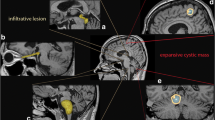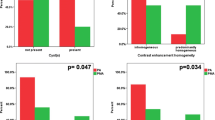Abstract
Purpose
MRI has an important role in diagnosing pilocytic astrocytoma and post-surgical follow-up since the surgical approach has a leading role in its treatment. The purpose of our study is to provide an overview of the typical and atypical MRI findings in a series of pediatric patients with isolated—not NF1-related—pilocytic astrocytomas and to correlate specific MRI patterns with clinical variables.
Methods
This is a cross-sectional retrospective study providing the analysis of several clinical and neuroradiological findings from a cohort of pediatric pilocytic astrocytoma, starting from the data collected in the Fondazione IRCCS Istituto Neurologico Carlo Besta (FINCB) internal Cancer Registry during an 11-year time period (January 2008–January 2019).
Results
Fifty-six patients were included in the study. Median age at diagnosis was 9.4 years; a slight female prevalence was noticed (m/f ratio 44.6%/55.4%). The majority of pPAs had well-defined contours: 51 (91.1%), 47 (88.7%) were hypointense on T1-wi, all of them were hyperintense on T2-wi, 46 (90.2%) were hyperintense on FLAIR, and 48 (85.7%) were heterogeneous on T1-wi and T2-wi sequences. We found positive correlation between pPAs location and age (r = 0.017), and small degree of connection between pPAs location and gender (Cramer’s V = 0.268).
Conclusions
We presented typical and atypical pPAs MRI findings. Age and tumor location were positevely correlated, while degree of connection between gender and pPAs location was small. All of this may aid clinicians, most of all neuroradiologists, neurosurgeons, and neurologists in proper diagnoses and follow-up of these specific patient population.




Similar content being viewed by others
Data availability
Data sharing not applicable to this article as no datasets were generated or analyzed during the current study.
Code availability
Not applicable
Change history
10 August 2023
A Correction to this paper has been published: https://doi.org/10.1007/s10072-023-07004-3
References
Hawkins 2020, Ostrom QT et al (2022) CBTRUS statistical report: pediatric brain tumor foundation childhood and adolescent primary brain and other central nervous system tumors diagnosed in the United States in 2014-2018. Neuro Oncol 24(Suppl 3):iii1–iii38. https://doi.org/10.1093/neuonc/noac161
Poretti A, Meoded A, Huisman TA (2012) Neuroimaging of pediatric posterior fossa tumors including review of the literature. J Magn Reson Imaging 35(1):32–47. https://doi.org/10.1002/jmri.22722
Sievert AJ, Lang SS, Boucher KL, Madsen PJ, Slaunwhite E, Choudhari N, Kellet M, Storm PB, Resnick AC (2013) Paradoxical activation and RAF inhibitor resistance of BRAF protein kinase fusions characterizing pediatric astrocytomas. Proc Natl Acad Sci U S A 110(15):5957–5962. https://doi.org/10.1073/pnas.1219232110
Chourmouzi D, Papadopoulou E, Konstantinidis M, Syrris V, Kouskouras K, Haritanti A, Karkavelas G, Drevelegas A (2014) Manifestations of pilocytic astrocytoma: a pictorial review. Insights Imaging 5(3):387–402. https://doi.org/10.1007/s13244-014-0328-2
Manik M, Rajesh S, Poonam S, Anchal G (2012) Densely calcified pilocytic astrocytoma in the sellar/suprasellar region. Int J Clin Pediatr 1:129–132
Burkhard C, Di Patre PL, Schüler D, Schüler G, Yaşargil MG, Yonekawa Y, Lütolf UM, Kleihues P, Ohgaki H (2003) A population-based study of the incidence and survival rates in patients with pilocytic astrocytoma. J Neurosurg 98(6):1170–1174. https://doi.org/10.3171/jns.2003.98.6.1170
Arai K, Sato N, Aoki J et al (2006) MR signal of the solid portion of pilocytic astrocytoma on T2-weighted images: is it useful for differentiation from medulloblastoma? Neuroradiology 48:233–237
Lee YY, Van Tassel P, Bruner JM, Moser RP, Share JC (1989) Juvenile pilocytic astrocytomas: CT and MR characteristics. AJR Am J Roentgenol 152:1263–1270
Lee CS, Huh JS, Sim KB, Kim YW (2009) Cerebellar pilocytic astrocytoma presenting with intratumor bleeding, subarachnoid hemorrhage, and subdural hematoma. Childs Nerv Syst 25:125–128
McAuley E, Brophy H, Hayden J, Pettorini B, Parks C, Avula S, Mallucci C, Pizer B (2019) The benefit of surveillance imaging for paediatric cerebellar pilocytic astrocytoma. Childs Nerv Syst 35(5):801–805. https://doi.org/10.1007/s00381-019-04078-3
Sutton LN, Cnaan A, Klatt L, Zhao H, Zimmerman R, Needle M, Molloy P, Phillips P (1996) Postoperative surveillance imaging in children with cerebellar astrocytomas. J Neurosurg 84:721–725
Fernandez C, Figarella-Branger D, Girard N, Bouvier-Labit C, Gouvernet J, Paz Paredes A, Lena G (2003) Pilocytic astrocytomas in children: prognostic factors--a retrospective study of 80 cases. Neurosurgery 53(3):544–553. https://doi.org/10.1227/01.neu.0000079330.01541.6e
Horger M, Beschorner R, Nägele T, Danz S, Ernemann U (2009) Pilozytisches Astrozytom: Bildgebende Diagnostik [Pilocytic astrocytoma: imaging findings]. Rofo 181(12):1109–1112. https://doi.org/10.1055/s-0029-1241999
Gaudino S, Martucci M, Russo R, Visconti E, Gangemi E, D’Argento F, Verdolotti T, Lauriola L, Colosimo C (2017) MR imaging of brain pilocytic astrocytoma: beyond the stereotype of benign astrocytoma. Childs Nerv Syst 33(1):35–54. https://doi.org/10.1007/s00381-016-3262-4
Mair MJ, Wöhrer A, Furtner J, Simonovska A, Kiesel B, Oberndorfer S, Ungersböck K, Marosi C, Sahm F, Hainfellner JA, Rössler K, Preusser M, Widhalm G, Berghoff AS (2020) Clinical characteristics and prognostic factors of adult patients with pilocytic astrocytoma. J Neurooncol 148(1):187–198. https://doi.org/10.1007/s11060-020-03513-9
Villanueva KG, Rea ND, Krieger MD (2019) Novel surgical and radiologic risk factors for progression or recurrence of pediatric pilocytic astrocytoma. Pediatr Neurosurg 54(6):375–385. https://doi.org/10.1159/000503110
Vetrano IG, Valentini LG, DiMeco F, Prada F (2021) Intraoperative Contrast-enhanced ultrasound in the pediatric neurosurgical patient. In: Sidhu P, Sellars M, Deganello A (eds) Contrast-enhanced ultrasound in pediatric imaging. Springer, Cham. https://doi.org/10.1007/978-3-030-49691-3_19)
Falco J, Höhne J, Broggi M, Rubiu E, Restelli F, Vetrano IG, Schiariti M, Mazzapicchi E, Bonomo G, Ferroli P, Schebesch KM, Acerbi F (2022) Fluorescein-guided surgery for the resection of pilocytic astrocytomas: a multicentric retrospective study. Front Oncol 12:943085. https://doi.org/10.3389/fonc.2022.943085
de Laurentis C, Bteich F, Beuriat PA, Mottolese C, Giussani C, Szathmari A, Vinchon M, Di Rocco F (2022) Sodium fluorescein in pediatric neurosurgery: a systematic review with technical considerations and future perspectives. Childs Nerv Syst. https://doi.org/10.1007/s00381-022-05772-5
Aknowledgements
The study was supported by the Italian Ministry of Health; most of the authors of this publication are members of European Reference Network of Paediatric Oncology (ERN-PaedCan).
Author information
Authors and Affiliations
Contributions
All authors contributed to the study conception and design. All authors read and approved the final manuscript. Valentina Opancina: conceptualization, methodology, supervision, project administration, and writing. Silvia Esposito: data curation, investigation, writing. Francesco Di Meco: methodology, writing, and editing. Eleonora Bruno: data curation, methodology, writing, and editing. Marco Moscatelli: data curation, methodology, writing, and editing. Ignazio G. Vetrano: data curation, methodology, writing, and editing. Luisa Chiapparini: data analyses, methodology, writing, and editing. Miljan Opancina: data analysis, methodology, and writing. Mariangela Farinotti: data curation, methodology, writing, and editing. Nebojsa Zdravkovic: data analysis, methodology, and writing. Bianca Pollo: data curation, methodology, writing, and editing. Gianluca Marucci: data curation, methodology, writing, and editing. Fabio M. Doniselli: conceptualization, methodology, supervision, project administration, and writing. The first draft of the manuscript was written by Valentina Opancina and all authors commented on previous versions of the manuscript. All the authors have made significant contributions to the manuscript, have agreed to the order in which their names appear and take public responsibility for the content of the study. All authors agree to be published.
Corresponding author
Ethics declarations
Ethics approval
This study was performed in line with the principles of the Declaration of Helsinki. Approval was granted by the Institutional Review Board from the Research Neurological Institute Carlo Besta.
Consent to participate
Informed consent was obtained from all individual participants included in the study.
Consent for publication
Patients signed informed consent regarding publishing their data and photographs.
Competing interests
The authors declare no competing interests.
Additional information
Publisher’s note
Springer Nature remains neutral with regard to jurisdictional claims in published maps and institutional affiliations.
Rights and permissions
Springer Nature or its licensor (e.g. a society or other partner) holds exclusive rights to this article under a publishing agreement with the author(s) or other rightsholder(s); author self-archiving of the accepted manuscript version of this article is solely governed by the terms of such publishing agreement and applicable law.
About this article
Cite this article
Opancina, V., Esposito, S., Di Meco, F. et al. Magnetic resonance imaging characteristics of pediatric pilocytic astrocytoma. Neurol Sci 44, 4033–4040 (2023). https://doi.org/10.1007/s10072-023-06893-8
Received:
Accepted:
Published:
Issue Date:
DOI: https://doi.org/10.1007/s10072-023-06893-8




